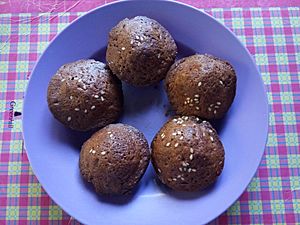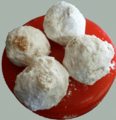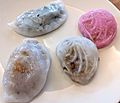Kuih facts for kids
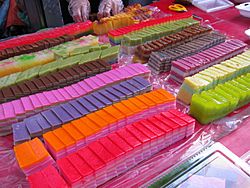
Colourful kuih
|
|
| Alternative names | Kue (Indonesia), Kueh (Singapore, Hokkien and Teochew) |
|---|---|
| Course | Snack |
| Region or state | Southeast Asia and China |
| Associated national cuisine | Brunei, China, Malaysia, Singapore, Indonesia (Kue) |
| Main ingredients | Various traditional snacks |
| Similar dishes | Kueh, Mont, Khanom, Bánh, Kakanin |
Kuih are small, tasty snacks or desserts. You can find them all over Southeast Asia and China. The word kuih comes from the Chinese words kueh or koé.
These treats can be like cakes, cookies, dumplings, or puddings. Most kuih are made from rice or glutinous rice. In China, the original word "kueh" means snacks usually made from rice. Sometimes they are made from other grains like wheat.
The name kuih is popular in Malaysia, Brunei, and Singapore. In Indonesia and Singapore, people also say kueh or kue. All these words mean sweet or savory snacks.
You can find similar snacks in nearby countries like Vietnam, Thailand, and Myanmar. For example, the colorful steamed kue lapis is also enjoyed there. In the Philippines, these snacks are called kakanin.
Kuih can be eaten any time of day. They are a big part of celebrations like Hari Raya and Chinese New Year in Malaysia, Indonesia, Brunei, and Singapore. Many kuih are sweet, but some are savory. Kuih are often steamed instead of baked. This gives them a different texture and taste compared to Western cakes.
What are Kuih Made Of?
Most Malay kuih use common ingredients for flavor. These include grated coconut, coconut cream, and pandan leaves. Pandan leaves come from the screwpine plant. Another key ingredient is gula melaka, which is palm sugar.
The main ingredients for the texture of kuih are different types of flour. These include rice flour, glutinous rice flour, and tapioca flour. Green bean flour is also used. These flours help make kuih soft and firm, almost like a pudding. Wheat flour is rarely used in these Southeast Asian snacks.
Traditionally, there isn't one exact recipe for most kuih. Grandmothers and other women often made them by "agak-agak," which means "approximation." They would mix ingredients by hand without measuring. The final snack was judged by how it looked and felt. Each family and region has its own special recipes.
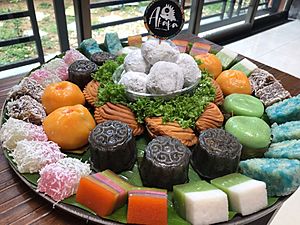
Nyonya kuih are a special type of kuih. They are made by the Peranakan people. Many Nyonya kuih are similar to Malay or Indonesian kuih. Sometimes, small changes are made to suit Peranakan tastes.
Popular Malay and Peranakan Kuih
Here are some popular types of kuih:
- Apam balik – This is a pancake that is folded over. It has crispy edges and is cooked on a griddle. It's usually topped with sugar, ground peanuts, corn, and grated coconut.
- Bahulu – These are tiny, crispy sponge cakes. They come in fun shapes like buttons or goldfish. They are baked in special molds. Bahulu are often served during holidays.
- Borasa – Similar to Bahulu, but with added palm sugar and sesame seeds.
- Cucur – These are deep-fried fritters. Some common types are cucur udang (with whole prawns) and cucur kodok (banana fritters).
- Curry puff – A small pie filled with a spicy curry mix. It usually has chicken or potatoes inside. The pastry shell is either deep-fried or baked.
- Kuih akok – A rich, sweet treat from Kelantan and Terengganu. It's made with lots of eggs, coconut milk, flour, and brown sugar.
- Kuih cara – A pandan-flavored Malay kuih. It's made from eggs, sugar, coconut milk, and flour. It's baked in special molds for its unique shape.
- Kuih cincin – A deep-fried dough snack. It's popular with Muslim communities in East Malaysia.
- Kuih gulung or kuih ketayap – These are mini crepes rolled up. They have a sweet coconut filling with palm sugar. The crepes are colored green with pandan.
- Kuih jala – A traditional fried snack from Sabah and Sarawak. Rice flour batter is poured through small holes into hot oil. It forms a crispy, thread-like layer.
- Kuih jelurut – Also called kuih selorot in Sarawak. It's made from palm sugar and rice flour. It's rolled into cone shapes with palm leaves and then steamed.
- Kuih kapit – These are crispy, folded wafer biscuits. People sometimes call them "love letters."
- Kuih keria – Fried doughnuts made from sweet potato batter. They are rolled in sugar.
- Kuih kochi – Glutinous rice dumplings with a sweet filling. They are shaped like pyramids and wrapped in banana leaves.
- Kuih lapis – A sweet steamed cake with many colorful layers. It's made from rice flour, coconut milk, and sugar.
- Kuih lidah – This kuih means "tongue" in Malay. It comes from the Bruneian Malay community in Papar, Sabah.
- Kuih makmur – A traditional Malay kuih made from butter, ghee, and flour. It's white and usually round. It's served during Eid al-Fitr.
- Kuih modak – A rice flour dumpling filled with sweet coconut and jaggery.
- Kuih pie tee – A Nyonya specialty. It's a thin, crispy pastry shell. It's filled with a spicy and sweet mix of vegetables and prawns.
- Kuih pinjaram – A saucer-shaped, deep-fried fritter. It has crispy edges and a chewy center. You can find it at street markets in East Malaysia.
- Kuih serimuka – This kuih has two layers. The bottom is steamed glutinous rice. The top is a green custard layer made with pandan juice.
- Kuih talam – This kuih also has two layers. The top is white, made from coconut milk and rice flour. The bottom is green, flavored with pandan.
- Kuih wajid or wajik – A sweet Malay treat made from glutinous rice. It's cooked with coconut milk and palm sugar.
- Onde onde – Small, round balls made from glutinous rice flour. They are green from pandan and filled with palm sugar syrup. They are rolled in grated coconut.
- Pulut inti – Wrapped in a banana leaf, this kuih is shaped like a pyramid. It has glutinous rice with candied grated coconut on top.
- Pulut panggang – Glutinous rice parcels wrapped in banana leaves and grilled. They have a spiced filling. This filling can be dried prawns, caramelized coconut, or beef floss. In Sarawak, it has no filling and is wrapped in pandan leaves.
- Putu piring – A round steamed cake made from rice flour dough. It has a sweet peanut or coconut filling with palm sugar.
Popular Chinese Kuih
- Chwee kueh (Chinese: 水粿) or wah kueh (Chinese: 碗粿) – These are steamed rice cakes shaped like bowls. They are topped with diced preserved radish and chili. They are popular in Taiwan and among Chinese communities in Southeast Asia.
- Ang koo kueh (Chinese: 紅龜粿) – A small, red, oval-shaped Chinese pastry. It has a soft, sticky glutinous rice flour skin. Inside is a sweet filling.
- Ku chai kueh (Chinese: 韭菜粿) – A savory steamed dumpling from the Teochew people. It's filled with chives.
- Niangao (Chinese : 年糕) or kuih bakul – A brown, sticky, sweet rice cake. It's often eaten during Chinese New Year. You can also find it as a street food. Pieces of niangao are put between slices of taro and sweet potato, then deep-fried.
- Or Kuih (Chinese : 芋粿) – A steamed savory cake made from taro (also called "yam") and dried prawns. It's topped with fried shallots, spring onions, and chili. It's usually served with chili sauce.
- Red peach cake (Chinese: 飯粿, png kueh) – A savory steamed dumpling from the Teochew people. It's filled with glutinous rice and often dyed pink.
- Soon kueh (Chinese: 笋粿) – A savory steamed dumpling from the Teochew people. It's made of glutinous rice dough and filled with jicama, bamboo shoot, and dried shrimp.
- Yi buah/buak (Chinese : 意粑) – A Hainanese steamed dumpling. It's made of glutinous rice flour dough. It's filled with a sweet mix of grated coconut, toasted sesame seeds, and crushed peanuts. It's wrapped in banana leaves and often has a red mark. This kuih is traditionally served at weddings and baby celebrations.
See also
 In Spanish: Kuih para niños
In Spanish: Kuih para niños


